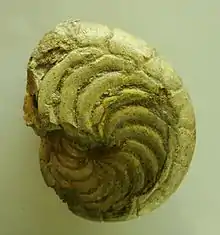Aturia
Aturia is an extinct genus of Paleocene to Miocene nautilids within Aturiidae, a monotypic family, established by Campman in 1857 for Aturia Bronn, 1838, and is included in the superfamily Nautilaceae in Kümmel 1964.
| Aturia | |
|---|---|
 | |
| Fossils of Aturia species | |
| Scientific classification | |
| Kingdom: | Animalia |
| Phylum: | Mollusca |
| Class: | Cephalopoda |
| Subclass: | Nautiloidea |
| Order: | Nautilida |
| Family: | †Aturiidae Chapman, 1857 |
| Genus: | †Aturia Bronn, 1838 |
Aturia is characterized by a smooth, highly involute, discoidal shell with a complex suture and subdorsal siphuncle. The shell of Aturia is rounded ventrally and flattened laterally; the dorsum is deeply inpressed. The suture, one of the most complex in the Nautiloidea, has a broad flattened ventral saddle, narrow pointed lateral lobes, broad rounded lateral saddles, broad lobes on the dorso-umbilical slopes, and a broad dorsal saddle divided by a deep, narrow median lobe. The siphuncle is moderate in size and located subdorsally in the adapical dorsal flexture of the septum. Based on the feeding and hunting behaviors of living nautiluses, Aturia most likely preyed upon small fish and crustaceans.

Aturia is likely derived from species of the genus Aturoidea of the family Hercoglossidae. Fossils of Aturia species are fairly cosmopolitan, being found from Paleogene-aged to Miocene-aged marine strata throughout the world: after the Miocene, the various species disappear from the fossil record. In contrast to Nautilidae, Aturia has no modern descendants.
See also
- List of nautiloids
References
- Kümmel, Bernhard, 1964; Nautiloidea- Nautilida, Chap in the Treatise on Invertebrate Paleontology, Vol K, Curt Teichert and R.C. Moore, eds, University of Kansas Press and the GSA.
- Moore, Lalacker, and Fischer; Invertebrate Fossils, McGraw-Hill Pub. 1952; chapter on cephalopods.
- Garima Sharma; Prehistoric Life, DK Pub. 2009